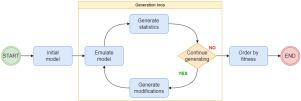利用模型驱动方法和演化策略优化物联网架构
IF 7.6
3区 计算机科学
Q1 COMPUTER SCIENCE, INFORMATION SYSTEMS
引用次数: 0
摘要
物联网(IoT)通过连接数十亿台产生连续数据流的设备,正在迅速改变现代世界。它的快速扩张将应用范围从家庭自动化扩展到几乎所有行业。由于组件、交互和应用需求的复杂性,选择合适的物联网架构越来越具有挑战性。在部署之前确保物联网架构满足性能、可靠性和资源限制对于避免低效率和瓶颈至关重要。在设计阶段模拟物联网架构允许架构师测试不同的物联网架构,并在各种条件下评估系统性能。这有助于确保最佳的资源利用和响应。已经提出了几种仿真方法,特别是基于模型驱动开发(MDD)的方法来建模和分析物联网环境。这些方法提供了复杂物联网架构的高级抽象,实现了系统的实验和评估。这项工作引入了一种新的方法和工具,用于使用进化方法模拟和改进物联网架构。它们允许架构师基于可配置参数(如延迟和CPU使用率)评估和改进性能。通过迭代的物联网架构修改和测试,所提出的基于mdd的方法优化了系统设计,确保最终架构经过微调,为给定应用程序提供最佳性能。并以智能停车为例进行了验证。本文章由计算机程序翻译,如有差异,请以英文原文为准。

Optimizing IoT architectures by using model driven approach and evolution strategy
The Internet of Things (IoT) is rapidly transforming the modern world by connecting billions of devices that generate a continuous flow of data. Its rapid expansion has broadened applications from home automation to nearly every industry. Selecting an appropriate IoT architecture is increasingly challenging due to the complexity of components, interactions, and diverse application requirements. Ensuring that an IoT architecture meets performance, reliability, and resource constraints before deployment is essential for avoiding inefficiencies and bottlenecks. Emulating IoT architectures during the design phase allows architects to test different IoT architectures and assess system performance under various conditions. This helps ensure optimal resource utilization and responsiveness. Several simulation approaches, particularly those based on Model-Driven Development (MDD), have been proposed to model and analyse IoT environments. These methodologies provide high-level abstractions of complex IoT architectures, enabling systematic experimentation and evaluation. This work introduces a novel methodology and tools for simulating and refining IoT architectures using a evolutionary approach. They allow architects to assess and improve performance based on configurable parameters such as latency and CPU usage. Through iterative IoT architecture modifications and testing, the proposed MDD-based approach optimizes system design, ensuring that the final architecture is fine-tuned to deliver the best possible performance for a given application. The proposal is validated by a case study related with a smart parking.
求助全文
通过发布文献求助,成功后即可免费获取论文全文。
去求助
来源期刊

Internet of Things
Multiple-
CiteScore
3.60
自引率
5.10%
发文量
115
审稿时长
37 days
期刊介绍:
Internet of Things; Engineering Cyber Physical Human Systems is a comprehensive journal encouraging cross collaboration between researchers, engineers and practitioners in the field of IoT & Cyber Physical Human Systems. The journal offers a unique platform to exchange scientific information on the entire breadth of technology, science, and societal applications of the IoT.
The journal will place a high priority on timely publication, and provide a home for high quality.
Furthermore, IOT is interested in publishing topical Special Issues on any aspect of IOT.
 求助内容:
求助内容: 应助结果提醒方式:
应助结果提醒方式:


